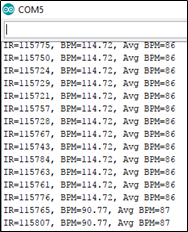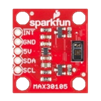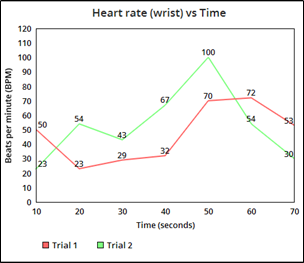One of the main features and aims of the minder smart watch is to be able to detect a panic attack. One of the main symptoms of a panic attack is a sudden increase in heart rate. The positioning of the smart watch on the user's wrist meant that the only way to detect heart rate would be via readings from the user's wrist. In-order to calculate the accuracy of such a reading I tested heart rate readings from both the finger and wrist (since the Sparkfun sensor I used recommended readings from the finger over the wrist). I conducted the test using the Sparkfun MAX30105 heart rate sensor.
The readings were taken from the Arduino IDE serial monitor:

MAX 30105 Test:


Trial 1: Heart rate reading on finger
| Time (secs) | BPM |
| 10 | 60 |
| 20 | 77 |
| 30 | 85 |
| 40 | 87 |
| 50 | 73 |
| 60 | 86 |
| 70 | 86 |
Trial 2: Heart rate reading on finger
| Time (secs) | BPM |
| 10 | 60 |
| 20 | 78 |
| 30 | 86 |
| 40 | 87 |
| 50 | 86 |
| 60 | 79 |
| 70 | 86 |
Graph:

Trial 1: Heart rate reading on wrist
| Time (secs) | BPM |
| 10 | 50 |
| 20 | 23 |
| 30 | 29 |
| 40 | 32 |
| 50 | 70 |
| 60 | 72 |
| 70 | 53 |
Trial 2: Heart rate reading on wrist
| Time (secs) | BPM |
| 10 | 23 |
| 20 | 54 |
| 30 | 43 |
| 40 | 67 |
| 50 | 100 |
| 60 | 54 |
| 70 | 30 |
Graph:

Clearly the heart rate readings from the wrist are very inaccurate as opposed to the finger readings. This is a major issue as it does not enable the watch to take accurate heart rate readings and subsequently alert the user of an upcoming panic attack. After doing some further research wrist heart rate readings appear to be very inaccurate even when used by some of the most advanced smart watches on the market (such as Apple watch and fitbit) and therefore I will need to further develop my own heart rate monitoring system.
 Austin Marandos
Austin Marandos
Discussions
Become a Hackaday.io Member
Create an account to leave a comment. Already have an account? Log In.